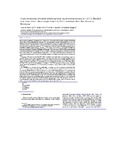Characterization of enriched lithospheric mantle components in ∼2.7 Ga Banded Iron Formations: An example from the Tati Greenstone Belt, Northeastern Botswana

View/
Date
2009Author
Døssinga, L.N.
Frei, R.
Stendal, H.
Mapeo, R.B.M.
Publisher
Elsevier www.elsevier.com/locate/precamresType
Published ArticleMetadata
Show full item recordAbstract
Major and trace element, samarium (Sm)–neodymium (Nd) and lead (Pb) isotopic analyses of individual
mesobands of five Banded Iron Formations (BIFs) and associated volcanic and sedimentary rocks from
the Neoarchean Tati Greenstone Belt (TGB, Northeastern Botswana) were conducted in order to characterize
the source(s) and depositional environment(s). Rare earth element (REE)–yttrium (Y) patterns of
individual BIF mesobands showfeatures characteristic of other Archean BIFs with LREE depletion relative
to MREE and HREE, positive La/La∗PAAS, Eu/Eu∗PAAS, Y/Ho ratios and no Ce/Ce∗PAAS anomalies. The REY patterns
are comparable to modern seawater and together with low concentrations of high-field strength
elements these features are indicative of an essentially detritus-free precipitation. Elevated Eu anomalies
in the TGB BIFs are a general feature observed in ∼2.7 Ga BIFs worldwide and possibly result from
widespread magmatic activity and associated high-temperature fluid fluxes to the oceans at around this
time.
Uranogenic Pb isotope data for the BIFs define correlation lines with slopes corresponding to apparent
ages of ∼2.7 Ga which brackets the depositional timeframe. Pb isotope data on sulfides and Pb-stepwise
leaching (PbSL) data on garnets define a correlation line with an apparent age of 1976±88 Ma. This age is
similar to tectono-metamorphic events within the adjacent Limpopo belt. Elevated 207Pb/204Pb relative
to 206Pb/204Pb ratios of BIFs are indicative of a high- (238U/204Pb) prehistory of their source materials
which can best be modeled by a 3.0–3.2 Ga extraction of these sources from an older Archean mantle
reservoir.
The TGB BIFs show evidence of two periodically interacting water masses during the deposition. The
first is characterized by elevated Sm/Nd ratios and a negative inferred εNd(2.7 Ga) value of −2.5 and is
associated with high Fe fluxes. The second source, associated with high Si fluxes, is characterized by
lower Sm/Nd ratios and a less negative inferred εNd(2.7 Ga) value of −0.4. While the association of high Fe
concentrations and elevated Sm–Nd in BIF mesobands is characteristic of hydrothermal seawater input,
the Sm–Nd isotopic characterization of this source, unlike other Archean BIFs, points to a significantly
LREE enriched mantle source. This finding is compatible with the potential existence of a sub-continental
lithospheric mantle reservoir beneath the Zimbabwe and Kaapvaal craton. The old (up to ∼3.5 Ga) Nd
(TDM) model ages, particularly of iron-rich mesobands of the TGB BIFs, support such a scenario. In contrast,
Si-rich solutes were likely derived from weathering of mafic continental crust.
